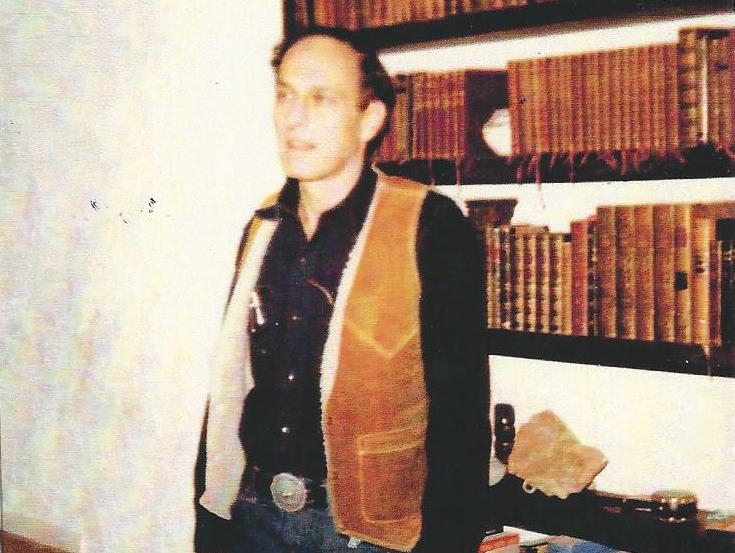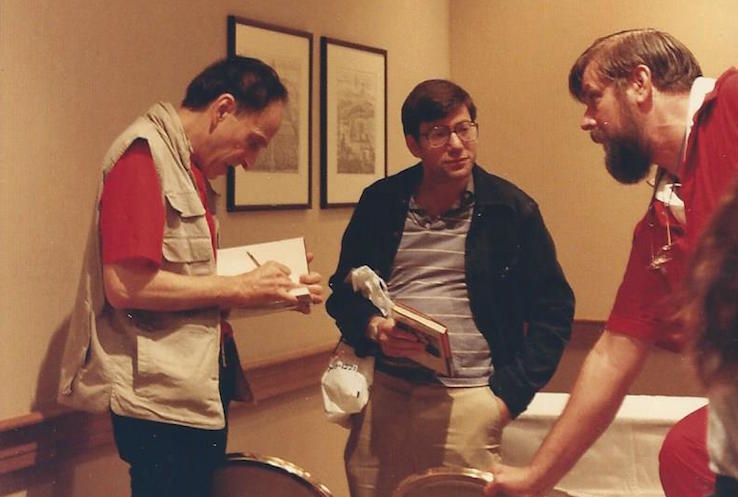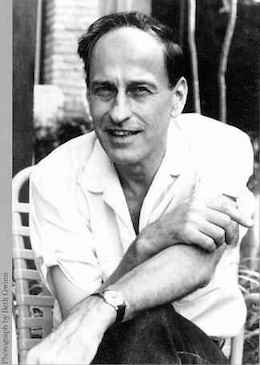Roger Zelazny’s biographer and friend, Ted Krulik, is sharing insights and anecdotes from the author.
In my 1982 interview with Roger, I pointed out that there were continuous threads in his later works that he had used in earlier stories. One such thread is the often combative pairing of a protagonist with an older man who acts, to some extent, as his mentor. We see examples of this thread in relationships between Gallinger and Emory in “A Rose for Ecclesiastes,” between Corwin and Bill Roth in The Chronicles of Amber, and between William Blackhorse Singer and Edwin Tedders in Eye of Cat.
It occurred to me that perhaps Roger was trying to express certain concerns he had in real life by reworking them in his writing. His response was that all the things he knew, all of his associations, flowed into his writing without his having to call them up consciously. “It’s the nature of the unconscious-type plotting approach I use,” Roger told me. “I let a story take form, quite often, below decks. I begin writing when I feel the story is in existence. It’s just a matter of my evoking it. Afterwards I can look back at it and can see those earlier elements also.”
The Nature of the Human Mind
The personal interests that Roger developed, as is true for many of us, were initiated in his formative years. It was through the influence of teachers in high school and college that Roger began to take his writing seriously and learn about the inner workings of human relationships. As he explained:
In high school, Myron Gordon and Ruby Olson both encouraged me. In addition to being my journalism teacher, Myron Gordon was the faculty advisor on the school newspaper. He recommended me for the school editorship. So I got to see him outside of class quite a bit. I wrote news articles for the paper.
Ruby Olson taught English but she never was my teacher. I had entered one of those National Scholastic Contests and received the prize. She asked me if I’d be interested in joining the creative writing club she held after school. It wasn’t really a class. I didn’t do a lot of writing there; it was mostly talk. The talking apparently did help me. She was very well read. When she said a book was worth taking a look at, it usually was. She’d give us assignments, recommending we look into something to write about.
When I got to college, I didn’t take writing classes, just the standard freshman composition class. At Case Western Reserve University in Cleveland, I started taking psychology courses. I was interested in the nature of the human mind, the structure itself, pathologies with which it is afflicted. I really intended to be a writer all along but I needed to take a subject that I could make a living at, either teaching it or doing it. Psychology interested me on both counts.
The Psych Department had a number of people who were theoreticians who taught Freud, Jung, and various social theories. Those were things that interested me. Around my junior year, there was a big shake-up in the department. Most of those professors left. A lot of professors who were Behaviorists came in who were more interested in running rats through mazes than studying the theorists.
If this was the way the department was going, I saw that it wasn’t the sort of background I wanted to study. So I switched my major to English instead of pursuing a career of running rats through mazes.
—Santa Fe, NM, 1982

Sinister Overtones
Another continuous thread that runs through Roger’s fiction is the symbol of the automobile as part of a malevolent alliance. We see obvious examples of this in stories like “Auto-Da-Fe,” “Devil Car,” and the reoccurring examination of the car accident that caused Corwin’s memory loss in The Chronicles of Amber.
Roger had been involved in a car accident himself that I suspected influenced his fictitious view of the automobile as a symbol of malice. In answering my query, he began talking of his own experience. He began his account with hesitation, speaking in hushed tones:
It was a rainy day in 1964. I was driving on a one-way stretch of road in Ohio with my fiancée [Sharon Steberl]. I didn’t realize that the road would merge and become a two-way. There wasn’t any clearly marked sign to indicate that.
A car headed for me from the other direction.
I would have avoided it if the other driver hadn’t turned his wheel. We were trying to avoid each other. We both swerved in the same direction. It was very nearly a head-on collision.
I was knocked out. Later, I found I chipped a tooth and my face was cut up. I had hit the rearview mirror and it shattered in my face. I didn’t have any broken bones.
My fiancée broke one of her bones in her heel and was hospitalized. It wasn’t a permanent crippling.
I know I have a thing about automobiles which occurs in a number of my stories. But the occurrence of accidents involving automobiles in my stories is just a tool for me.
Once you put a person inside a car, it’s the car you’re thinking about, not the person. If a person walking on the street rushes across my path, I wouldn’t think about it. But if a driver in a car speeds through a stop sign to cross in front of me, I’d get very irritated. So there is a psychological effect that a car produces on us.
Some people do become more irresponsible when they get into a car. There are an awful lot of deaths by automobile accidents. Something like two thousand people die in car crashes every year. Santa Fe has some crazy intersections where invariably one can almost predict how many accidents will occur there on a given day.
Do I consider cars as symbolic of something evil? A car may very well be a death symbol in some of my stories. If I’m looking for a good way to get rid of a character, an auto accident generally will occur to me.
But in real life? An automobile is just a machine. Nothing more from a practical standpoint. A machine. With sinister overtones.
—Santa Fe, NM, 1982
The Yellow Pages
When asked, “Where do you get your ideas?” Harlan Ellison famously answered, “Schenectady.” For Roger, the very question itself has no meaning. Ideas are everywhere. In writing a piece of fiction, it becomes more a matter of what is needed at that point in the plot to move a story along. To work out his plot points, Roger often drew on his interest in how things work; not only the basic mechanics of things but also the way any organized system functions.
This is how he told it:
I have a fondness for technology. It’s great to spend hours puttering around with mechanical things gotten from junkyards and visualizing what their use might be. Especially if you come across a gadget or tool and you don’t know what it is and you try to figure it out. I’m fascinated by processes, whatever they might be.
That’s one of the things I like about writers like Heinlein and John D. McDonald. Both of them are very interested in how things work. Not just, say, an outboard motor or a television set, but how corporate finance works. All the things that go on in running a bank or operating a successful illegal enterprise of some sort or meteorology – different things that create weather patterns. Just the whole idea of process and breaking things down into their parts and seeing how they fit together, do whatever it is they’re supposed to do. There’s an intrinsic fascination for me just in the process itself that I enjoy describing things like that in detail.
It’s the same fascination you get looking through The Yellow Pages in a telephone directory, to see how things go, what is available in society. Some time ago I asked a cartoonist of one of the Dailies the one question science fiction writers don’t like to be asked: where do you get your ideas for your stories? Only I asked him: “Where do you get your ideas for your cartoons?”
He answered, “The Yellow Pages. It’s got every good and service you need in our society.” He would take some job or product and put it in a slightly skewed set of circumstances as he worked on his cartoon.
I tried writing stories that way. I’d take something at random from The Yellow Pages and project it into the future to see what that sort of business might become. I did that in “The Doors of His Face, The Lamps of His Mouth” with the job of a baitman. I thought it worked out rather well.
—Santa Fe, NM, 1982
Didactic Tendency
Roger’s interests in a variety of genres and topics were, of course, far-ranging and he pursued some of them in his own career. He dabbled in the writing of poetry, some of which had been published in To Spin Is Miracle Cat and When Pussywillows Last in the Catyard Bloomed. With nature writer Gerald Hausman, he wrote the nonfiction adventure Wilderness.
At Lunacon in 1989, I asked whether he felt a need to impart knowledge to his readers that they might not ordinarily have. He responded with a smile and some ready humor:
You mean, do I have a didactic tendency buried beneath the story-telling impulse somewhere wherein I enjoy passing out odd bits of information while writing? [Pause] No. [Laughs].
I do admire great essayists. I’m a particular fan of good nature writing. People like Robert Finch. I read great quantities of writing by naturalists. I’ve been studying the genre for years. I may do something in that area at some time.
I think that also I could try writing a bit about music. If I try writing on both music and nature, I would like to incorporate them into my fiction and also write separate essays. I’ve always been intrigued by forms of writing which strike me as possessing peculiar problems. It’s only in recent years that I realized how tricky it is to write good music criticism. I’d begun studying it through the years as an intellectual pursuit. I don’t know if I’ll ever use what I learned in the area but usually you wind up using everything even if it’s not in the manner you intended.
But, yeah, nature writing and music are areas I’ve never done much of anything in, which I could. But I’ve strayed a bit from your question.
I do like to sneak in odd bits of information. It’s not really a “show-off” impulse, I don’t think. I like to find unusual things that fit the theme which I am pursuing. I suppose I’m a bit of a frustrated poet. I’ve never pursued poetry in the way I intended years ago, primarily because one can’t make a living at it. But I read some poetry every day. I think that the dredging up of unusual associations and strewing them along as analogies in one’s storylines is, in its way, comparable to the creation of striking metaphors, as one would do in writing poetry. It brings the reader to an abstract level, very much as poetry lifts a reader to another level.
—Lunacon, Tarrytown, NY, 1989
Life as a Writer
When Roger and I sat across from one another in his hotel room in Tampa in 1985, he confided in me about his attitude on being a professional writer:
That’s the nice thing about being a writer. It’s not like working for a company somewhere, where you know when you reach a certain age you have to retire and stop doing what you’ve been doing all your life. Most writers, if they really like what they do, will keep right on doing it as long as they can.
One of the virtues of the sort of life I lead is that I have a lot of freedom. I don’t have to get up at a particular time and be at a particular place to work. I can write anywhere. I don’t have to dress in any particular way. My life is easily accommodated because of what I do.
I don’t have the same rhythms in my life as a lot of other people. If I want to keep writing when I’m ninety years old, I’ll keep doing it.
—Necronomicon, Tampa, FL, 1985

 Theodore Krulik’s encyclopedia of Roger Zelazny’s Amber novels, The Complete Amber Sourcebook, published in 1996 by Avon Books, is still the most exhaustive reference book on that revered series. Through his literary biography Roger Zelazny, published by Frederick Ungar Inc. in 1986, Krulik made accessible to the enthusiast the famed author’s personal concerns. For the first time, aficionados discovered the sources in Zelazny’s own life that inspired his writing. Other literary work includes essays on Richard Matheson in Critical Encounters II for Ungar, edited by Tom Staicar, and on James Gunn’s The Immortals in Death and the Serpent for Greenwood Press, edited by Carl Yoke and Donald Hassler. As a member of the Science Fiction Research Association, Krulik wrote a regular column for their newsletter in the 1980s and 90s entitled “The Shape of Films To Come.” Currently, he is writing a novel about a science fiction writer who gains remarkable powers to see into the minds of others. Krulik hopes to complete World Shaper by the end of 2017.
Theodore Krulik’s encyclopedia of Roger Zelazny’s Amber novels, The Complete Amber Sourcebook, published in 1996 by Avon Books, is still the most exhaustive reference book on that revered series. Through his literary biography Roger Zelazny, published by Frederick Ungar Inc. in 1986, Krulik made accessible to the enthusiast the famed author’s personal concerns. For the first time, aficionados discovered the sources in Zelazny’s own life that inspired his writing. Other literary work includes essays on Richard Matheson in Critical Encounters II for Ungar, edited by Tom Staicar, and on James Gunn’s The Immortals in Death and the Serpent for Greenwood Press, edited by Carl Yoke and Donald Hassler. As a member of the Science Fiction Research Association, Krulik wrote a regular column for their newsletter in the 1980s and 90s entitled “The Shape of Films To Come.” Currently, he is writing a novel about a science fiction writer who gains remarkable powers to see into the minds of others. Krulik hopes to complete World Shaper by the end of 2017.










